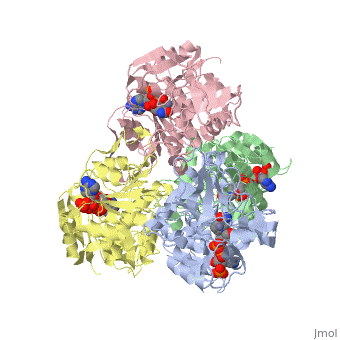JMS/sandbox5
From Proteopedia
(Difference between revisions)
| Line 1: | Line 1: | ||
== Structure == | == Structure == | ||
<StructureSection load='1ykf' size='350' side='right' caption='Structure of alcohol dehydrogenase from the thermophile Thermoanaerobacter brockii (PDB entry [[1ykf]])' scene=''> | <StructureSection load='1ykf' size='350' side='right' caption='Structure of alcohol dehydrogenase from the thermophile Thermoanaerobacter brockii (PDB entry [[1ykf]])' scene=''> | ||
| - | TbADH has an extraordinary ability to remain folded in extreme temperatures - up to 95 degrees celsius! How an enzyme can withstand these extreme temperatures depends on enthalpic and entropic strategies, as seen from the GIbb's equation: ∆G = ∆H - T∆S; Where ∆G is negative, the products form spontaneously, which in our context means proteins will fold spontaneously. From the equation is is clear that to maintain a value of ∆G, the enzyme has two available paths. It can decrease ∆H, or it can increase ∆S. TbADH does both. | + | TbADH<scene name='JMS/sandbox5/Tbadh/1'>TextToBeDisplayed</scene> has an extraordinary ability to remain folded in extreme temperatures - up to 95 degrees celsius! How an enzyme can withstand these extreme temperatures depends on enthalpic and entropic strategies, as seen from the GIbb's equation: ∆G = ∆H - T∆S; Where ∆G is negative, the products form spontaneously, which in our context means proteins will fold spontaneously. From the equation is is clear that to maintain a value of ∆G, the enzyme has two available paths. It can decrease ∆H, or it can increase ∆S. TbADH does both. |
Professor Yigal Burstein and colleagues, at the Weizmann Institute of Science, have demonstrated two strategies, through experiments using chimers. First, through an ion-binding network in the interface of the monomers, the enzyme has a decreased enthalpy in the folded state, meaning it is more stable - ∆H decreases. TbADH also has proline amino acids at strategic positions. Because proline undergoes fewer configurational changes in an unfolded protein, therefore there is less restriction of its movement in the folded state, which means the loss in entropy is less, and therefore ∆S increases. | Professor Yigal Burstein and colleagues, at the Weizmann Institute of Science, have demonstrated two strategies, through experiments using chimers. First, through an ion-binding network in the interface of the monomers, the enzyme has a decreased enthalpy in the folded state, meaning it is more stable - ∆H decreases. TbADH also has proline amino acids at strategic positions. Because proline undergoes fewer configurational changes in an unfolded protein, therefore there is less restriction of its movement in the folded state, which means the loss in entropy is less, and therefore ∆S increases. | ||
Revision as of 14:38, 21 November 2012
Structure
| |||||||||||

